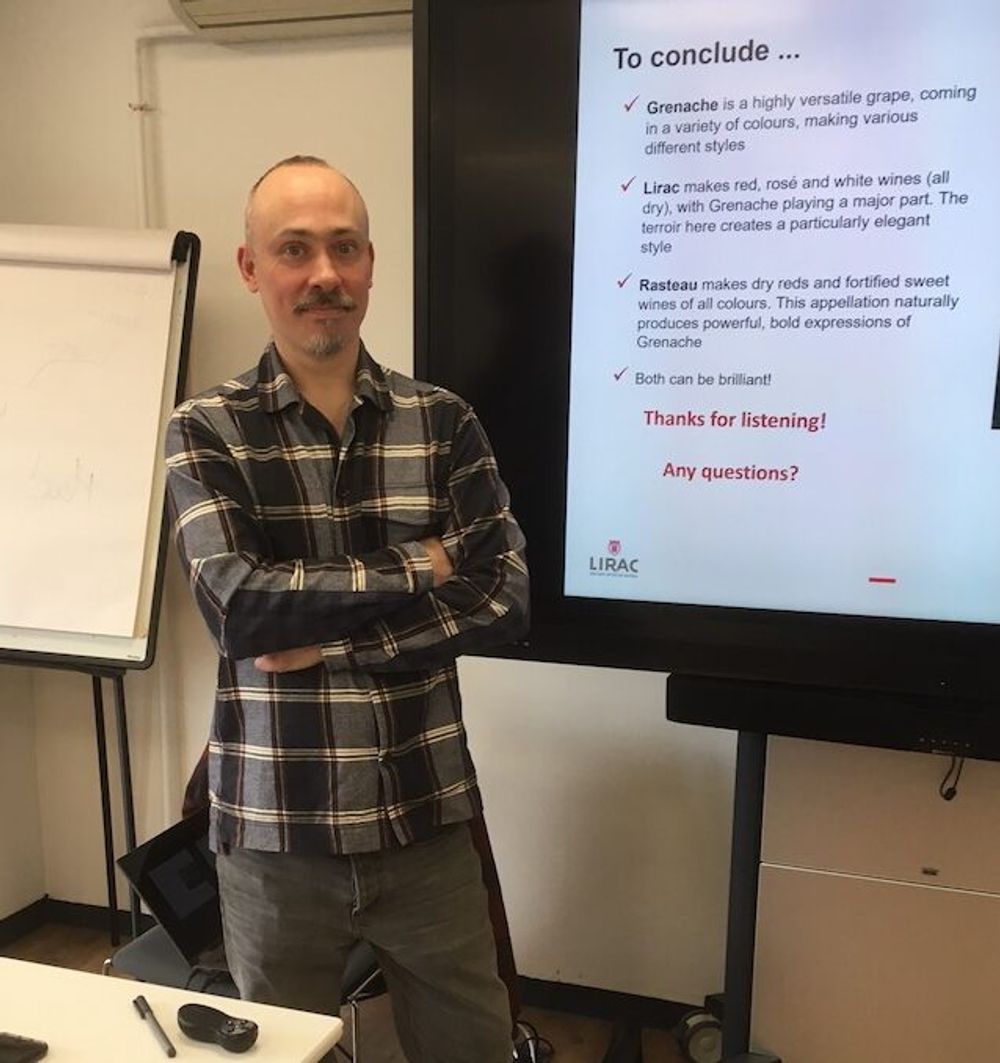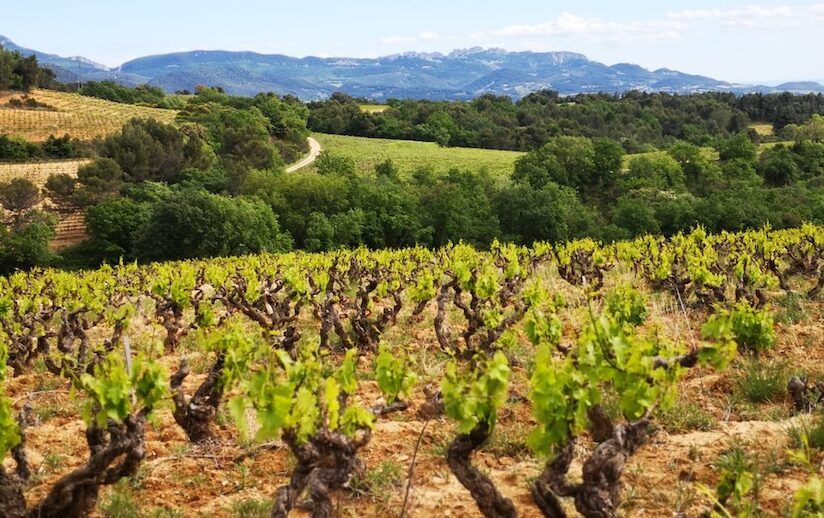“Well-priced, made by families in beautiful surroundings who have a proper understanding of sustainability and are either organic or going that way,” says Walls of the wines of Lirac and Rasteau.
Ask your average wine drinker to name a Southern Rhône appellation and the chances are they will say Châteauneuf-du-Pape – by far and away the best known – or, at a pinch, if they are more knowledgeable, rocky Gigondas, or perhaps Vacqueyras. Recognition of the other AOCs, in the UK market at least, is pretty low, which makes the initiative by some of them to hold masterclasses very welcome, not least because most are being hosted by none other than Matt Walls, AKA Mr Rhône from Decanter.
It is vanishingly rare for an issue of the wine lovers’ magazine to pass without something from Walls on either the northern or southern Rhône. Little wonder perhaps when you consider just how vast these two very different wine regions are: when I asked him just how many AOCs the Rhône is home to, he said “around 54, but it depends how you count them.”
So, more than enough to keep those Decanter readers busy then, especially if you include wines from Côtes-du-Rhône and Côtes-du-Rhône Villages, which together account for some 60% of total wine production from the two regions. My brief was to look at two very different crus: Lirac, lying on the Right Bank of the Rhône river, and Rasteau on the Left Bank. Grenache is king in both, while they share the famous Mistral winds, in common with other areas of le Midi, but there, the similarities largely end.

Rasteau was historically famous for its VDNs or ‘Vins Doux Naturelles’
Understanding the differences
France not being one of my regular wine patches, I’ll come clean and admit I’d never heard of Rasteau, except maybe as a mispronounced description of a dreadlocked follower of Bob Marley. However, the AOC’s official tagline, ‘Corps et Âme’ or Body and Soul, gives a good clue to the nature of its intense, deep reds and its enticingly delicious Vins Doux Naturels (VDNs), sweet, fortified wines made here for many years but now rarely seen outside the region – a reflection of changing consumer tastes which has encouraged producers to focus on still red wines instead. Rasteau has 961 hectares of vines producing red wines, while the total production area for its red, white and pink VDNs is just five hectares.

Lirac lies on the Right Bank of the Rhône
Lirac I had heard of – my wine-loving godfather used to insist its wines were a great value alternative to Châteauneuf-du-Pape, using much the same grape varieties – while an unhappier claim to fame is that this might have been where phylloxera began, when the owner of Château de Clary bought some cuttings over from America in 1863 to see how they would fare. The upshot was not very well at all, but the aphids attached to them thrived and travelled, eventually making their way to Roussillon, Bordeaux and beyond, almost destroying Europe’s wine industry by the end of the century. These days, Lirac has 796 hectares under vine, with red wines accounting for 87% of production, white 11% and rosé 2%.
The title of Matt Walls’ masterclass was Two Contrasting Styles because despite Lirac and Rasteau lying so close to each other, they produce almost disconcertingly different wines. Lirac, which makes red, white and rosé wines from a range of varieties dominated by Grenache (Noir and Blanc), tends towards elegance, with nuanced wines reflecting its diverse range of soils – limestone, sand and sand mixed with small stones – protective woodland and (usually) east-facing vineyards looking towards the Rhône. Lying just 15 km north-west of Avignon, this is an AOC with a long history dating back to the Roman era, with its wines enjoyed by European nobility for centuries until phylloxera. Lirac became a cru of the Côtes-du-Rhône in 1947.
Rasteau, by contrast, has very warm, south-facing vineyards and wines with great depth, whose diversified pebbly and clayey terroir (among which are the well-known “blue marls”) gives them richness and finesse – these tend to be powerful, concentrated and bold expressions of Grenache with wines at 15% ABV by no means unusual. Not shy then, but with lots of complexity and character, the red wines acquired cru status in 2010 (though Rasteau VDN was awarded cru status back in 1944), final recognition of their increased quality and consistency, as well as the relative fading away of VDNs, sadly.

So what were the Lirac wines like?
Walls showed us four wines from Lirac and Rasteau respectively – each of them very different. The only white, Château d’Aqueria 2021, AOC Lirac (Thorman Hunt £18.50) was a blend of Grenache Blanc (40%) Bourboulenc (25%), Clairette (16%) and Rousanne (12%) – the four varieties which must go into white Lirac – along with Viognier (7%). The estate, with mainly limestone-based soil, was originally founded by monks but last year was acquired by Guigal, a good quality addition to its impressive portfolio. This is not an overly aromatic wine, but nicely textured and quite rounded, with citrus and white pear notes on the palate.
The three Lirac AOC reds were quite distinct and, as with the Rasteau wines, all from different vintages. Château Bourcarut, Pierres Vivantes 2020 (not currently listed in the UK), a hand harvested wine from a property founded in 1758, with largely sandy soils, a spicy, dark berry and cherry fruit-dominant un-fined blend of Grenache Noir (60%), Syrah (30%) and 5% each of Cinsault and Mourvèdre, added to provide silkiness, elegance and power. Very decent.
Next up, the Xavier Vignon 2019 (£15 from the Big Red Wine Company), 80% Grenache, 20% Syrah, a juicy, fruit forward, but well balanced blend made by an established local vigneron, 70% fermented and aged in concrete, 30% in wood for 18 months, an approach giving authentic expression to the varieties. Moreish and distinctive.
And finally Clos de Serenes 2017 (not currently listed in the UK), 60% Grenache, 30% Cinsault, and 5% each of Carignan and Mourvèdre – the later varieties Walls says are being planted more extensively in the AOC. Made from vines more than 50 years old, this was fruit forward but with a slightly stewed, fusty aftertaste, I felt.
And how about the wines from Rasteau?
Moving to Rasteau and starting with Domaine des Escaravailles Heritage 1924, 2020 (Haywood Brothers, £27.99) which, as its name suggests, is grown on 100-year-old vines, which look down onto the pretty village of Rasteau. 100% Grenache, this has power and character – as well as 15% alcohol, so not a lunchtime tipple.
Next up, Domaine la Colliere: Espirit d’Argiles 2019 (£19 from Thorman Hunt), a well priced, well made blend of 68% Grenache, 22% Mourvèdre and 10% Syrah, this newish estate is clearly going places: the wine is forceful – 15% ABV again – but there is a lifted, red fruit-dominant character in the flavour profile, maybe a hint of brett supporting the slightly rustic character.
Then, Domaine Rabasse Charavin 2017 (not currently listed in the UK), 60% Grenache, 35% Mouvèdre and 5% Carignan, is made by a 5th generation family domaine with 40 hectares spread across Rasteau and neighbouring crus; some of the hillside vines from which the grapes grow are over 70 years old, resulting here in a well-balanced finely textured wine, with red and dark berry fruit, supported by fine tannins.
And so to the last wine, Domaine des Coteaux des Travers Lambertlas 2015 (not currently listed in the UK), a VDN, made with 100% Grenache Noir and checking in at 17% ABV – a good alcohol level for this not overly sweet wine – made by a winery first established in 1920, which converted to organic in the 1980s after being taken over by Robert Charavin. Full bodied, the wine spends 30 months in ambre barriques before bottling. Very moreish, a wine to treasure, particularly as it is so hard to get hold of outside the southern Rhône. “An authentic, traditional and delicious expression of Rasteau – we have to hope this style doesn’t die out,” says Walls.

Masterclass host, Decanter’s Matt Walls
So what to say in conclusion?
For that, I shall hand back to Matt: “These are wines that are doing increasingly well in the trade. They are well-priced, made by families in beautiful surroundings who have a proper understanding of sustainability and are either organic or going that way,” he says.
I would have to agree, particularly with regard to the price-to quality ratio, and the sheer authenticity of these wines. With prices shooting up everywhere, and sterling stuck in the doldrums, getting well-made wines of this quality for prices typically in the mid-to late-teens in pounds is pretty remarkable. Going forward, I shall most certainly be looking out for the wines of Lirac and Rasteau.
































